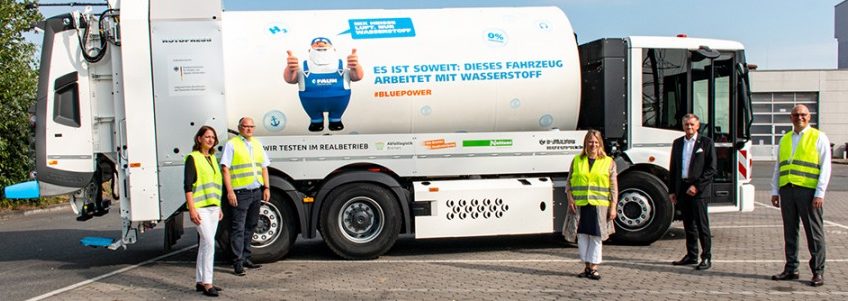Osterholz-Scharmbeck, 5 August 2020 – With the official ceremonial start by Lower Saxony's Minister President Stephan Weil, the series production of hydrogen-powered commercial vehicles has commenced at FAUN in Osterholz-Scharmbeck. Together with Bernd Lütjen, District Administrator of Osterholz, Torsten Rohde, Mayor of Osterholz-Scharmbeck, Patrick Hermanspann, FAUN CEO, and Matthias Kohlmann, FAUN CEO and Honorary President of the Stade Chamber of Commerce & Industry, as well as FAUN shareholder Dr. Johannes F. Kirchhoff, the Minister President cut the symbolic blue ribbon.
Starting in 2021, waste collection vehicles and sweepers powered by BLUEPOWER hydrogen will be in series production here. The entire development from the prototype to the vehicle ready for series production was funded with approximately half a million euros from the Federal Ministry of Transport and Digital Infrastructure as part of the National Innovation Programme Hydrogen and Fuel Cell Technology (NIP). Funding support for the project was coordinated by NOW GmbH.
The BLUEPOWER vehicle chassis combine hydrogen fuel cell and battery technology. In August, a hydrogen vehicle will go into real-world testing in Bremen. The first customer vehicles will be delivered in autumn. “I am delighted to be giving the kick-off today for a pioneering technology. The hydrogen vehicles from Lower Saxony will contribute to a climate-neutral infrastructure in the future,” said Minister President Weil during the opening ceremony. FAUN is one of the leading suppliers of waste collection vehicles and sweepers in Europe and has been working intensively on hydrogen technology for years. FAUN CEO Patrick Hermanspann: “Our goal is one hundred percent emission-free cities for all. I imagine a future without energy concerns. Only with hydrogen will we be able to achieve a climate-neutral transport sector. Hydrogen is the new oil, and we firmly believe we will deliver more hydrogen vehicles than diesel within five years.
Green hydrogen can be produced by means of electrolysis from renewable energies such as wind turbines, photovoltaics or waste incineration plants. The energy from hydrogen is used to power the vehicles. The advantage of hydrogen: it is light and can be refuelled like today’s fuels. Long-lasting battery recharging processes are therefore a thing of the past.

